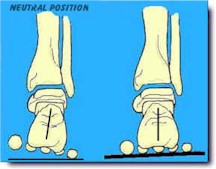The Case of the Non Rotating Knee
Here is a runner, wanting to be an ultra runner, who recently developed right sided knee pain while running a 50K. He was pacing another individual and developed pain on the outside (lateral patella and knee) on the right, ascending and especially descending hills. The pain is dull and achy. He is able to “push through” the pain, but if he does, it remains painful for a few days.
He has an anatomically short leg on the L (tibial). There is no significant tibial torsion (he has normal external version) and not femoral torsion. There are adequate amounts of internal (>15 degrees) and external (>30 degrees) rotation of the hips.
He has 7 degrees ankle dorsiflexion on the right, 10 degrees on the left. On the table (and in the video) he has 0 degrees of hip extension during passive motion, walking and running. He has weakness of the long extensors of the toes, as well as the abductors.
Take a look at his video. Note the following:
· the right knee has less medial excursion than the left (watch the dots)
· rearfoot valgus is noted on the L (ie. calcaneus is everted)
· subtle lean to Left on L sided stance phase
· when barefoot, the problem lessens
Why does the right knee rotate less than the left?
When folks have a short leg, we generally expect that leg to remain in supination (thus external rotation) more and the longer leg to internally rotate more, due to excessive pronation. But here, we see the opposite. You will notice he has a rearfoot valgus on the left. This means the midtarsal joint is in a greater amount of pronation on the shorter side. For every action, there is an equal and opposite reaction. In this case, less pronation (or supination) on the longer leg side. Remember, we said generally folks pronate more on the long leg side. This is one of the exceptions.
So, should he throw away his shoes?
The shoes, which have a certain amount of torsional rigidity, are compounding the problem. The Brooks Cascadia is an excellent trail running shoe, he just needs something with less torsional rigidity. the shoe does not allow his knee to come midline sufficiently. Since he is a Brooks Fan, we suggested the “Grit” in the Pure line. 4mm drop and less rigid torsionally. He could also work his way into a “Drift” (4mm or zero drop, extremely flexible).
Why does he lean to the left on stance phase on the left?
Most likely, to clear the right long leg on swing phase. This is one of the 5 common strategies. For more strategies, click here.
Why is it better when he is barefoot? It must mean he should be a barefoot runner, right?
He is better, because there is less impediment to the foot pronating (ie. the shoe has less torsional rigidity)
The Gait Guys. Making you a better diagnostician, with each and every post.


















